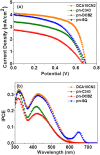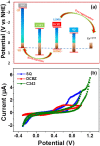Discrete photoelectrodes with dyes having different absorption wavelengths for efficient cobalt-based tandem dye-sensitised solar cells
- PMID: 28536467
- PMCID: PMC5442119
- DOI: 10.1038/s41598-017-02480-y
Discrete photoelectrodes with dyes having different absorption wavelengths for efficient cobalt-based tandem dye-sensitised solar cells
Abstract
A pn-tandem dye-sensitised solar cell (pn-DSSC) employing a set of sensitisers with complementary absorption spectra and a less-corrosive cobalt-based electrolyte is presented. We applied three organic sensitisers (denoted C343, DCBZ, and SQ) featuring different absorption wavelengths for the p-DSSC, while keeping the n-DSSC sensitiser (denoted DCA10CN2) constant. Characterisation of the Co+2/+3-based DSSC devices revealed that SQ dye, with a longer absorption wavelength, showed broader spectra and increased photocurrent activity in the visible and near-infrared region compared to the other two devices with C343 and DCBZ in the pn-DSSCs. As a result, the short-circuit current density increased significantly to 4.00 mA cm-2, and the devices displayed overall power conversion efficiencies of as high as 1.41%, which is comparable to that of the best pn-DSSCs in the literature. Our results demonstrate that complementary absorption between the two photoelectrodes is important for enhancing the photovoltaic performance of pn-DSSCs.
Conflict of interest statement
The authors declare that they have no competing interests.
Figures





Similar articles
-
Organic Dyes with Well-Defined Structures for Highly Efficient Dye-Sensitised Solar Cells Based on a Cobalt Electrolyte.Chemistry. 2015 Oct 12;21(42):14804-11. doi: 10.1002/chem.201502289. Epub 2015 Sep 1. Chemistry. 2015. PMID: 26332091
-
A theoretical study on the role of the π-spacer in the thoughtful design of good light-absorbing dyes with phenothiazine for efficient dye-sensitized solar cells (DSSCs).J Mol Model. 2023 Dec 12;30(1):5. doi: 10.1007/s00894-023-05783-2. J Mol Model. 2023. PMID: 38085377
-
Molecular Engineering of Zinc-Porphyrin Sensitisers for p-Type Dye-Sensitised Solar Cells.Chempluschem. 2018 Jul;83(7):711-720. doi: 10.1002/cplu.201800104. Epub 2018 May 2. Chempluschem. 2018. PMID: 31950629
-
Redox Shuttle-Based Electrolytes for Dye-Sensitized Solar Cells: Comprehensive Guidance, Recent Progress, and Future Perspective.ACS Omega. 2023 Feb 6;8(7):6139-6163. doi: 10.1021/acsomega.2c06843. eCollection 2023 Feb 21. ACS Omega. 2023. PMID: 36844550 Free PMC article. Review.
-
A comprehensive review of dye-sensitized solar cell optimal fabrication conditions, natural dye selection, and application-based future perspectives.Environ Sci Pollut Res Int. 2022 Jan;29(1):371-404. doi: 10.1007/s11356-021-16976-8. Epub 2021 Oct 21. Environ Sci Pollut Res Int. 2022. PMID: 34674131 Review.
References
-
- Green MA, Emery K, Hishikawa Y, Warta W, Dunlop ED. Solar cell efficiency tables (version 44) Prog. Photovolt: Res. Appl. 2014;22:701–710. doi: 10.1002/pip.2525. - DOI
-
- Han L, et al. High-efficiency dye-sensitized solar cell with a novel co-adsorbent. Energy Environ. Sci. 2012;5:6057–6060. doi: 10.1039/c2ee03418b. - DOI
Publication types
LinkOut - more resources
Full Text Sources
Other Literature Sources
Molecular Biology Databases
Research Materials

